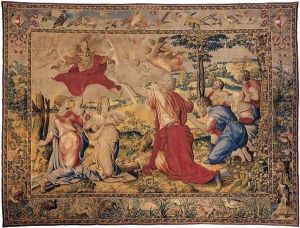Willem de Pannemaker Paintings
Willem de Pannemaker was a prominent Flemish weaver and tapestry maker of the 16th century, born in the 1510s and passing away in 1581. He hailed from a distinguished family of tapestry weavers, which was highly regarded in Brussels, a leading center for tapestry production during the Renaissance. The Pannemaker family, with Willem at the forefront in the mid-16th century, played a significant role in elevating the artistry and prestige of Flemish tapestries, making them coveted items among the nobility and royalty across Europe.
Willem de Pannemaker specialized in producing large-scale tapestries that were renowned for their intricate design, rich coloration, and detailed depiction of scenes ranging from biblical and mythological to historical and allegorical. His works were characterized by their sophisticated composition and the high quality of the wool and silk used, which allowed for a wide range of colors and a depth of texture that was unparalleled at the time. Pannemaker's workshop collaborated with some of the most renowned artists and designers of the era, who provided the cartoons (preliminary designs) from which the tapestries were woven. This collaboration between artists and weavers was instrumental in achieving the high artistic standards that Pannemaker's tapestries were known for.
During his career, Willem de Pannemaker received commissions from the most prestigious clients, including Emperor Charles V and Philip II of Spain, testament to his workshop's reputation for excellence. His works were considered symbols of wealth and power and played a role in the diplomatic exchanges between states. Pannemaker's contributions to the tapestry industry were not only artistic but also technological, as he and his contemporaries developed new weaving techniques that allowed for even greater detail and realism in tapestry art.
After his death in 1581, Willem de Pannemaker's legacy continued through the works he produced and the influence he had on the tapestry industry in Brussels and beyond. His tapestries remain highly valued by collectors and museums worldwide, representing the pinnacle of Renaissance tapestry weaving. Through his dedication to his craft, Pannemaker helped to secure the reputation of Flemish tapestries as among the most sought-after artworks of the Renaissance period.
